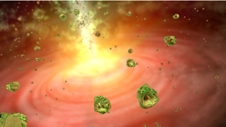
July Editorial
Olivine crystals in the envelope of a protostar

July Editorial
Olivine crystals in the envelope of a protostar
|
Olivine is a magnesium iron silicate. The rock takes its name from its typically olive-green colour which is caused by trace amounts of of nickel. While Olivine is a common mineral on Earth it can also be found on other planets of our solar system. For example, according to the NASA Goddard Space Flight Centre there are 30,000 square kilometres of Olivine-bearing rock in the Nili Fossae region, north-east of Syrtis Major on Mars. Olivine can also be found on the Moon and in meteorites known as pallasites. Pallasites are stony-iron meteorites in which crystals of olivine are suspended in the nickel-iron matrix.
|
NASA has recently reported that their Spitzer Space Telescope has detected tiny crystals of olivine in the dusty clouds of gas that collapse around a star as it forms. Spitzer's infrared detectors spotted the crystal rain in the constellation of Orion as it swirled around a distant, sun-like embryonic star, or protostar, known as HOPS-68. The crystals are in the form of forsterite. Forsterite is the magnesium rich end-member of the olivine family. This is the first time that forsterite crystals have been detected in the dust cloud of a forming star, and the question is where these crystals have come from. | |
|
On Earth, forsterite-rich olivine is the most abundant mineral in first 400km of the mantle and it is a common crystallization product of mantle-derived magma. As the principal investigator in this study, Tom Megeath, points out: ‘You need temperatures as hot as lava to make these crystals’ (approximately to 700 degrees Centigrade - or 1,300 degrees Fahrenheit). So it is somewhat surprising to find them in the outer collapsing cloud of a protostar where temperatures hover around a chilly minus 170 degrees centigrate (-280 degrees Fahrenheit). The team suggests that one possible scenario is that the crystals were formed close to the surface of the protostar, and then blasted away into the surrounding cloud by jets of gas. Reaching a region where temperatures are much colder, some ultimately fall back to the surface like glitter (the above image shows a visual representation of olivine crystals in outer space). The NASA team argues that the same scenario might apply to comets, as some have been found to contain olivine. One such is the 81P/Wild comet, from the tail of which a NASA spacecraft named Stardust collected particle samples in 2004. Comets are born in regions of space where it is much colder than the temperatures needed to form olivine crystals. The question of how comets acquire their olivine crystals is currently explained by the theory that materials in our young solar system mingled together in a planet-forming disk. In this scenario, some materials that formed near the sun, such as the Olivine crystals, eventually migrated out to the cold outer regions of the solar system. But the authors of the present research argue that instead 'jets might have lifted crystals into the collapsing cloud of gas surrounding our early sun before raining onto the outer regions of our forming solar system. Eventually, the crystals would have been frozen into comets'. Journal Reference: Charles A. Poteet, S. Thomas Megeath, Dan M. Watson, Nuria Calvet, Ian S. Remming, Melissa K. McClure, Benjamin A. Sargent, William J. Fischer, Elise Furlan, Lori E. Allen, Jon E. Bjorkman, Lee Hartmann, James Muzerolle, John J. Tobin, Babar Ali. A Spitzer Infrared Spectrograph Detection of Crystalline Silicates in a Protostellar Envelope. The Astrophysical Journal, 2011; 733(2): L32 DOI: http://iopscience.iop.org/2041-8205/733/2/L32/ | |
| _______________________________ | ||||
| Home | | | Shopping | | | Database |
© Biscuit Software 2004-2015
All rights reserved